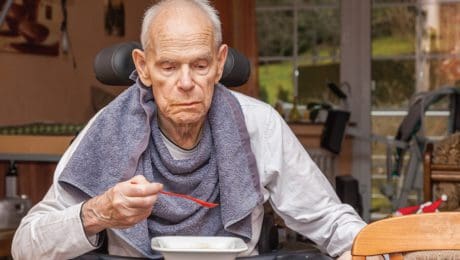CREATING AN ADVANCE DIRECTIVE
![]()
CREATING AN ADVANCE DIRECTIVE
HEALTH
© Page 1 of 2 | 0721
It is a good idea to speak with your loved one’s doctor about any potential future health risks. Including their physician also ensures that everyone is on the same page for long-term care decisions. It is worth noting that talking with the doctor about advance care planning during a wellness visit is covered by Medicare.
The most important things to take into consideration before making any specific decisions are your loved one’s personal values.
How do we want to be treated when we get to the end of our lives? What decisions would we like made on our behalf if we are unable to make them? Life is uncertain. It’s important to have a plan in place.
An Advance Directive is a document to let family and medical professionals know your desires should something happen. Work with your loved one to get these documents drafted while they are still able to speak clearly about their choices. Work together, instead of assigning it to them as a task, to ensure that you understand clearly what they want.
As a part of the Advance Directive, your loved one will often appoint someone as their healthcare proxy. This is the person that, if your older adult cannot make a medical decision themselves, will make the decision in accordance with their wishes. If you do not feel like you agree with the decisions that they are making in the Advance Directive, steer them to choose someone who might be more in line with their values. If there is a trusted medical professional in your family, perhaps this person might be better suited for this role.
Source: Death with Dignity
Where to Draft Your Advance Directive
The laws governing how a state will honor your Advance Directive vary from state to state. Often, one state will not honor an Advance Directive created in another state. If your loved one travels or resides in several states, it is recommended that you create an Advance Directive in each location.
Source: Death with Dignity
Some questions to consider:
- Is it important to them to be able to be mobile, so paralysis or coma may not be acceptable?
- Do they need the ability to speak to their loved ones or do they feel they could communicate in other ways should speech be impaired?
- Would they want pain medications at the end of life if it meant that they were drowsy and lethargic all the time?
- If in a facility, is it important to them that their pets and grandchildren can visit or be with them?
Source: National Institute on Aging and The Conversation Project – Institute for Healthcare Improvement
Additional Resources:
https://www.clearcareonline.com
https://deathwithdignity.org/learn/end-of-life-resources/
https://www.nia.nih.gov/health/advance-care-planning-health-care-directives
https://theconversationproject.org/
© Page 2 of 2 | 0721
Some of the Many Things to Think About for an Advance Directive:
- Are they open to the use of CPR?
- Are they willing to be put on a ventilator or other life sustaining mechanical apparatus? If so, for how long?
- What level of feeding/hydration is acceptable?
- What level of comfort care and pain medications are acceptable?
- Have they filled out an organ donation card?
- Do they want to live their last days in a hospital, in hospice, or at home?
- What if they require blood transfusions or organ transplants?
Many organizations offer online templates for Advance Care Directives that can be used as a starting point. Many hospitals will require the directives to be notarized.
Source: National Institute on Aging and The Conversation Project – Institute for Healthcare Improvement
What is a DNR (Do Not Resuscitate) Order?
A DNR order is a document that indicates to emergency and medical responders that the person does not want CPR or other life-restoring measures should their heart or breathing stop. In the moment, it may be hard to honor this wish. It is easier to have a clear directive and a healthcare proxy willing to make this decision on their behalf.
If your senior has indicated that they would like to donate their organs, they will need to note that the desire to donate supersedes the DNR since there may be a need to keep the heart beating until the organs can be taken for donation.
Source: National Institute on Aging
Additional Resources:
https://www.clearcareonline.com
https://www.nia.nih.gov/health/advance-care-planning-health-care-directives
https://theconversationproject.org/
Adapted from the original PDF document: “0721-MM-AdvanceDirective.pdf”
- Published in IN HOME CARE
ACTIVITIES FOR SENIORS
ACTIVITIES FOR SENIORS
ACTIVITIES
Children aren’t the only ones who pipe up with “I’m bored…”
- Reading audiobooks
- Cooking and baking
ACTIVITIES FOR SENIORS
ACTIVITIES
Some ideas for activities outside…
- Museums
- Senior centers
Volunteer
If your loved one has been active…
- Soup kitchens
- Animal shelters
Benefits
Research shows…
- Are more disease resistant
- Have a longer lifespan
- Published in IN HOME CARE
TELEVISION AND SENIORS
TELEVISION AND SENIORS
ACTIVITIES
It might surprise you to learn that older adults watch more television than younger people do. Watching TV comprises most of the leisure time for adults aged 70 to 105 years old. Television can be an avenue to learning new things, connecting with the world, creating a diversion, and providing some light entertainment. However, it can also supplant physical or recreational activities and real-world interactions.
Pluses and Minuses
If you are mindful, there are certainly benefits to TV for our older adults. As they become less able to go out to movies, concerts, or spectator sports, TV can fill this void. While some sitcoms and light viewing can help to relieve depression, sometimes the news or similar shows can make a depressed mood worse. It is important to pay attention to what our loved ones are watching and find a suitable balance.
The most notable down-side to excessive TV watching is some decrease in mobility. In general, a sedentary lifestyle choice can be detrimental to bone health, cellular/immunity function, and cardiovascular efficiency. Excessive TV use has been linked with a greater risk for Type 2 diabetes, obesity, lower life satisfaction, and an increased risk for dementia. Excessive TV viewing has also been linked with cognitive decline. This can be because viewers are not spending as much time doing things that can keep their minds sharp such as reading, playing board games, talking with friends and relatives, or working on puzzles. If they eagerly engage in conversation with you during a show, it can be an indication to you that they are simply using the TV to pass time and would prefer another outlet. It can help both you as the caregiver and your loved one to spark conversations based on the shows they are watching. Use open ended questions like “What decision would you have made in that situation?” or “When was the last time you did x activity?” or “Who does that character remind you of?”. You can also use a board game or book that is depicted in a show as a cue to suggest playing that game or start reading that book with your loved one. Source Medical News Today and National Institutes of Health
If TV has become an outlet for your loved one, try to ensure that they are also getting plenty of exercise and movement during the rest of the day. It can be helpful to set up a habit of having them stand up and stretching during commercials or take a walk to another room between shows. Incorporate exercises that can be done from a seated position into their day. On a nice day, suggest a quick walk outside or to a nearby window to watch “reality TV.”
TELEVISION AND SENIORS
What Are They Watching?
If your loved one is spending more than four hours a day watching TV, it is possible that they are simply using it to pass time, rather than to provide practical information or relaxation. If they cannot tell you what they just watched, it might be time to find an activity that is more brain engaging for them. If they insist on using the TV as an activity, perhaps ensure that their programming selection includes some of the following to help keep their spirits up:
- Light-hearted sitcoms
- Uplifting dramas
- Educational programs
- Sports or reality TV
- Movies from when they were young adults
Source: Center for Media Literacy
Where Are They Watching?
While cable TV and network programming continue to be the most accessible, more viewers are turning to streaming, where they have control of what they watch and when. These can be accessed by anyone with an internet connection and the correct hardware. If your loved one has a smart TV, most streaming services can be accessed directly through the TV interface. If you set this up for them, make sure to check the “remember me” box in the setup screen so that your loved one only needs to turn the TV on to watch their favorite shows. If your older adult does not have a smart TV, they will need a separate device to help manage the streaming services. Source Medical Alert Systems
Happiness Quotient
A new study by the University of Maryland concludes that unhappy people watch more TV, while people who describe themselves as very happy spend more time reading and socializing. Analyzing 30-years’ worth of data, the Maryland researchers report that spending time watching television may contribute to viewers’ happiness in the moment, with less positive effects in the long run. Source: Phys.org
Powered by WellSky
- Published in IN HOME CARE
FOOD SAFETY HEALTH
FOOD SAFETY
According to the Centers for Disease Control and Prevention (CDC) each year 48 million illnesses, 128,000 hospitalizations, and 3,000 deaths in this country can be traced to foodborne pathogens. We’ve probably all heard our older loved ones comment that they have always (insert poor food storage adage here) and it was fine. However, bacteria have evolved since their youth. There are both more types of bacteria and they are more resistant to the usual elimination methods. Food sources have become more global. Even fruits and vegetables are coming from other states and other countries. This both increases the number of pathogens that can be picked up between the place of origin and our homes and introduces new bacteria that wouldn’t be in our environment had we shopped locally. Source: Partnership for Food Safety Education
Who Is At Risk?
Adults aged 65 and older are at a higher risk for hospitalization and death from foodborne illnesses. There are several reasons for this:
- Their gastrointestinal tract holds food for longer, allowing more bacteria to grow.
- Liver and kidneys typically function at a lower level, not clearing bacteria and toxins as efficiently as when they were younger.
- Their stomach may not produce as much bacteria-reducing acid.
- Underlying chronic conditions such as diabetes and cancer increase the susceptibility to foodborne illnesses.
Source: FoodSafety.gov
Did You Know?
Flour, regardless of the brand, can contain bacteria that cause disease. Flour is ground from raw grain, which may be bleached, but not usually treated to kill bacteria like E. coli. The FDA recommends the following precautions:
- Do not eat raw cookie dough, cake mix, batter, or dough that is meant to be cooked.
- Follow instructions for cooking any products containing flour.
- Wash hands and work surfaces thoroughly after contact with dough or flour.
- Chill dough promptly if not baking immediately.
Source: Food and Drug Administration
FOOD SAFETY
Tips for Safer Food Storage and Handling
You can start practicing safe handling as soon as you choose your foods in the market. Here are some basic tips:
- Separate raw meat, poultry, seafood, and eggs from other foods in your shopping cart, grocery bags, and refrigerator. Use the plastic bags provided in the market (or your own) to further isolate these foods.
- Wash hands and surfaces often. Wash hands for at least 20 seconds before and after handling food. Rinse all fruit and vegetables, including those with rinds that won’t be eaten. Never place any food on an uncleaned surface.
- Refrigerate foods promptly in a fridge set to a temperature of 40°F or below. Bacteria that cause food poisoning multiply most quickly between 40°F and 140°F
- Never let raw meat, poultry, eggs, fish, cooked food, or cut fruits and vegetables sit at room temperature for more than two hours before refrigerating. Frozen foods should be kept at a temperature of 0°F or below.
- Do not defrost foods at room temperature. Defrost in the fridge, cold water, or the microwave. Cook immediately once they have been thawed.
- It is important to cook food at a temperature that kills the harmful bacteria. A food thermometer should be a staple for any home cook. While foods have a variety of ideal temperatures, a few minimums include:
- Roasts and steaks should be at least 145°F
- Poultry should be at least 165°F Check internal temperature at the innermost part of the thigh or wing and the thickest part of the breast.
- Ground meat should be at least 160°F The process of grinding distributes bacteria.
- Fish should be at least 145°F and/or until the flesh is opaque and flakes easily with a fork.
- Eggs should be cooked until the yolk and white are firm.
- When microwaving, stir and rotate to ensure there are no cold spots.
- Sauces and gravies should be brought to a boil when reheating.
- Other leftovers should be heated thoroughly to 165°F.
Source Partnership for Food Safety Education
Best If Used By
The date on your packaged food is to indicate the date by which the food will be the best flavor and quality. The date when the food is “bad” can be anywhere from days to months beyond that. Unfortunately, there are no universal rules for food dating. If you have questions or concerns about the quality, safety or labeling of the foods you buy, reach out to the company directly.
Source: Food and Drug Administration
Powered by WellSky
- Published in IN HOME CARE
STARTING A FITNESS ROUTINE
STARTING A FITNESS ROUTINE
STARTING A FITNESS ROUTINE
When thinking of starting a fitness regime, many people may envision smelly gyms, sweaty feet, and plenty of grunting and pain. Often lofty goals, such as races or competitions, sway people from starting a sensible routine. Fitness goals should be about improving our health and how we interact with the world, not about increasing our status. It’s never too late to start a fitness commitment. Exercise reduces risk of cardiovascular disease, hypertension, type 2 diabetes, osteoporosis, obesity, colon cancer, depression, and breast cancer. It also decreases the risk of falls and fall-related injuries. Consult their physician before having an older loved one start a new fitness program, especially if there are health concerns. Some tips to map a workout:
- Aim for just 15 to 30 minutes a day to start. Break workouts up into ten-minute increments throughout the day, if necessary.
- Make sure that they are drinking plenty of water before, during, and after their session.
- To minimize fall risk, ensure appropriate footwear for the activity. Start and end the workout with slower movements and activities.
- Don’t let them overdo it. The goal is not pain and exhaustion.
ACTIVITIES
Categories of Exercise
There are several types of activity to consider working into a weekly schedule.
Aerobic
Aerobic exercise is just as the word implies, good for the oxygen exchange between the lungs and heart. Aim for at least two hours of moderate aerobic exercise or one and a half hours of vigorous intensity each week. Spread this time over 3-5 days. Remember that vigorous for them may be significantly less than vigorous for you. Especially if they have a competitive nature, it should be stressed that they do not overdo it. Some examples of aerobic activity that might appeal to your loved one are:
- Brisk walking
- Biking
- Jogging
- Dancing
- Swimming
- Aerobic classes
- Yard work
- Tennis
- Golf (without a cart)
Questions for the Doctor Before Starting a Fitness Program
- Are there exercises or activities they should avoid?
- Is their preventative care up to date for example, tests for osteoporosis, diabetes, or cardio-fitness?
- How do any health conditions affect their ability to perform the selected activities?
- What modifications might be necessary to safely perform the activities?
Source: National Institute on Aging
STARTING A FITNESS ROUTINE
Categories of Exercise (continued)
Muscle Strengthening
Having stronger muscles has been proven to improve bone density. Aim for at least two days a week. The focus can be varied from session to session to include legs, hips, back, chest, abdomen, shoulders, and arms. To help build muscle, have your older adult start with a weight that they can safely lift for eight repetitions. The repetitions should be slow and controlled three seconds to lift the weight, hold for one second, then lower for three seconds. Breathe in as the weight is lifted and out as it’s lowered. Do these eight to fifteen times and then take a rest. If fifteen seems easy, consider increasing the weight by a pound. Some good muscle strengthening tools and activities include:
- Weight machines
- Handheld weights
- Yoga
- Exercise bands
- Calisthenics
- Tai Chi
- Digging, lifting, and carrying as a part of gardening
Balance
More than one third of senior citizens suffer from fall-related injuries. Improving balance should be a core goal for any exercise program. Aim for three or more days a week. Ensure that there are adequate safety measures in place, such as things or people to hold onto. Some easy exercises to consider include:
- Standing from a seated position
- Backward walking
- Sideways walking
- Heel walking
- Toe walking
- Standing on one leg
Stretching
Stretching is important and should be done at a minimum at the end of every workout. Do not allow your loved one to “bounce” the stretch or to stretch further than they can easily go to feel a slight tug. It should not hurt. Improvement will happen naturally.
Source: University of Nebraska, Institute of Agriculture and Natural Resources. National Institute on Aging, Harvard Medical School, and CDC
Motivation
It is never too late to start working out. A recent study showed that many of the losses in strength, flexibility, and stamina could be reversed, even in the frailest of participants. The study followed 100 participants, aged 72 to 98. They did resistance exercises three times a week for ten weeks. They showed marked improvement over their sedentary counterparts, being able to lift more weight, climb more stairs, and walk faster.
Powered by WellSky
- Published in IN HOME CARE
ORGANIZING FINANCES
POSITIVITY AND HEALTH
“Optimism is the most important human trait, because it allows us to evolve our ideas, to improve our situation, and to hope for a better tomorrow.” – Seth Godin [American Author]
HEALTH
Our minds are powerful tools for creating health and wellness. While studies haven’t identified precisely why positive people are healthier, researchers suspect that it is because people who are more positive process stress better and move through hard situations more easily. Negative attitudes and feelings of helplessness can create chronic stress, which can, in turn, damage the immune system. Anger and hostility are related to health conditions such as high blood pressure, cardiovascular disease, digestive disorders, and increased instances of infection. Surprisingly, the tendency toward a positive or negative outlook does have a genetic component. However, this doesn’t mean that people can’t improve their outlooks. Some tips to improve your outlook include:
- Smile more. Even fake smiling can reduce heart rate and blood pressure during stressful situations.
- Practice reframing. Instead of stressing about a current situation, try to find a positive aspect to it.
- Build resiliency. Having friends and family nearby to share the situation with, accepting that change is a part of life and finding new ways to adapt, and feeling like you have the control to change the current situation are all ways to embrace whatever life throws your way.
- Share your feelings. Often, we spend too much time in our heads. Sharing our feelings with a trusted other can help find a different way to look at a situation. If others are mired in their current negative situations, encourage them to share their fears.
Source: Johns Hopkins Medicine. University of Minnesota, and University of Wisconsin Health
While loved ones might resist the idea of optimistic thinking, there are health reasons to ask them to reconsider. Positive thinking can lead to:
- Better sleep
- Increased life span
- Lower levels of distress
- Lower rates of depression
- Greater resistance to the common cold
- Better cardiovascular health
- Better coping skills during extreme hardship
Tips for Creating a More Positive Outlook
- Get better sleep.
- Take a walk outside.
- Follow a healthy lifestyle.
- Practice positive self-talk.
- Surround yourself with positive people.
- Be open to humor or create a place for smiling and laughing every day.
- Consciously work on experiencing three positive emotions for every negative one.
- Actively evaluate your self-talk at various points during the day to see how you’re doing.
Source Mayo Clinic and University of Wisconsin Health
Powered by WellSky
POSITIVITY AND HEALTH
HEALTH
Are you a negative or positive thinker?
Listen to your own self-talk- that endless stream of unspoken thoughts that goes through your head. Some forms of negative self-talk to watch out for include:
- Filtering. This means magnifying the negative aspects of a situation and not acknowledging the positive. For example: Your loved one had a good night’s sleep, a fun phone call with their grandchild, and took a walk on a beautifully sunny day outside. But then they tripped and fell with minor injuries. At the end of the day, did they say it was a “bad” day because of the fall or a “good” day because of the rest?
- Personalizing. When something bad occurs, you or your loved one automatically takes the blame. Sometimes no one is to blame.
- Catastrophizing. You or your loved one uses language that makes things out to be much worse than they are, or assumes that because one bad thing happened, it’s all downhill from there. Single events in the day are rarely the “worst” or “most horrific.”
- Polarizing. You or your loved one sees things as either good or bad and not the huge gray area in the middle. This leads to feeling like one is only perfect or a failure; healthy or dying tomorrow, capable or completely incapacitated.
If you are seeing these tendencies in your loved one, you should take care to address the subject, as they are more likely to see it as an attack and apply all of the above thought processes to that interaction.
Source: Mayo Clinic
Positive Self-Talk
- Affirm daily what is good about you.
- Remove the words “never” and “always.”
- Express gratitude – either aloud or in your head.
- If you make a mistake, take a moment to forgive yourself.
- Don’t say anything to yourself that you wouldn’t say to someone else.
Source: Mayo Clinic
Powered by WellSky
- Published in IN HOME CARE
POSITIVITY AND HEALTH
TELEVISION AND SENIORS
ACTIVITIES
It might surprise you to learn that older adults watch more television than younger people do. Watching TV comprises most of the leisure time for adults aged 70 to 105 years old. Television can be an avenue to learning new things, connecting with the world, creating a diversion, and providing some light entertainment. However, it can also supplant physical or recreational activities and real-world interactions.
Pluses and Minuses
If you are mindful, there are certainly benefits to TV for our older adults. As they become less able to go out to movies, concerts, or spectator sports, TV can fill this void. While some sitcoms and light viewing can help to relieve depression, sometimes the news or similar shows can make a depressed mood worse. It is important to pay attention to what our loved ones are watching and find a suitable balance.
The most notable down-side to excessive TV watching is some decrease in mobility. In general, a sedentary lifestyle choice can be detrimental to bone health, cellular/immunity function, and cardiovascular efficiency. Excessive TV use has been linked with a greater risk for Type 2 diabetes, obesity, lower life satisfaction, and an increased risk for dementia. Excessive TV viewing has also been linked with cognitive decline. This can be because viewers are not spending as much time doing things that can keep their minds sharp such as reading, playing board games, talking with friends and relatives, or working on puzzles. If they eagerly engage in conversation with you during a show, it can be an indication to you that they are simply using the TV to pass time and would prefer another outlet. It can help both you as the caregiver and your loved one to spark conversations based on the shows they are watching. Use open ended questions like “What decision would you have made in that situation?” or “When was the last time you did x activity?” or “Who does that character remind you of?”. You can also use a board game or book that is depicted in a show as a cue to suggest playing that game or start reading that book with your loved one. Source Medical News Today and National Institutes of Health
If TV has become an outlet for your loved one, try to ensure that they are also getting plenty of exercise and movement during the rest of the day. It can be helpful to set up a habit of having them stand up and stretching during commercials or take a walk to another room between shows. Incorporate exercises that can be done from a seated position into their day. On a nice day, suggest a quick walk outside or to a nearby window to watch “reality TV.”
TELEVISION AND SENIORS
What Are They Watching?
If your loved one is spending more than four hours a day watching TV, it is possible that they are simply using it to pass time, rather than to provide practical information or relaxation. If they cannot tell you what they just watched, it might be time to find an activity that is more brain engaging for them. If they insist on using the TV as an activity, perhaps ensure that their programming selection includes some of the following to help keep their spirits up:
- Light-hearted sitcoms
- Uplifting dramas
- Educational programs
- Sports or reality TV
- Movies from when they were young adults
Source: Center for Media Literacy
Where Are They Watching?
While cable TV and network programming continue to be the most accessible, more viewers are turning to streaming, where they have control of what they watch and when. These can be accessed by anyone with an internet connection and the correct hardware. If your loved one has a smart TV, most streaming services can be accessed directly through the TV interface. If you set this up for them, make sure to check the “remember me” box in the setup screen so that your loved one only needs to turn the TV on to watch their favorite shows. If your older adult does not have a smart TV, they will need a separate device to help manage the streaming services. Source Medical Alert Systems
Happiness Quotient
A new study by the University of Maryland concludes that unhappy people watch more TV, while people who describe themselves as very happy spend more time reading and socializing. Analyzing 30-years’ worth of data, the Maryland researchers report that spending time watching television may contribute to viewers’ happiness in the moment, with less positive effects in the long run. Source: Phys.org
Powered by WellSky
- Published in IN HOME CARE
KIDNEY DISEASE HEALTH
KIDNEY DISEASE
What do our kidneys do?
Most people are aware that a major function of the kidneys is to remove waste products, drugs, toxins, and excess fluid from the body. The kidneys are super-efficient organs, filtering almost 200 quarts of fluid every day! This process helps maintain a stable balance of body chemicals enabling our bodies to perform their most basic functions without issue. Our kidneys also regulate the body’s salt, potassium, and acid content, as well as produce hormones that affect the function of other organs such as stimulating red blood cell production, regulating blood pressure, and controlling calcium metabolism.
Source: National Kidney Foundation
HEALTH
Because our kidneys support so many of our body’s functions, it is important to pay attention to their health. Chronic kidney disease, or chronic kidney failure, is a gradual loss of kidney function. As kidneys begin to fail, toxins build up in the body, causing many complications evidenced by some of the following symptoms:
- Nausea
- Vomiting
- Loss of appetite
- Fatigue and weakness
- Sleep problems
- Changes in how much you urinate
- Decreased mental sharpness
- Muscle twitches and cramps
- Swelling of feet and ankles
- Persistent itching
- Chest pain, if fluid builds up around the lining of the heart
- Shortness of breath, if fluid builds up in the lungs
- High blood pressure (hypertension) that’s difficult to control
Unfortunately, most of these symptoms are not specific and can be attributed to several other diseases. Additionally, the symptoms tend to come on slowly, further complicating our ability to notice them in our loved ones. Because the kidneys are highly adaptable and able to compensate for lost function, signs and symptoms may not appear until irreversible damage has occurred.
How to Reduce your Risk of Kidney Disease
- Follow the instructions on over-the-counter pain relievers. Taking too many pain relievers can cause kidney damage.
- Maintain a healthy weight.
- Don’t smoke.
- Work with your doctor to manage other conditions that might lead to kidney damage.
Source: Mayo Clinic

What Can Cause Kidney Disease?
There are several diseases and conditions that can contribute to the likelihood of kidney disease. If your loved one has one of these conditions, it is advisable to ask their doctor to keep an eye out for signs of kidney failure.
- Diabetes
- High blood pressure
- Heart and blood vessel (cardiovascular) disease
- Smoking
- Obesity
- Being African American, Native American or Asian American
- Family history of kidney disease
Source Mayo Clinic
Complications from Kidney Disease
Kidney disease can affect many areas of our loved one’s lives. Some of the complications to watch for include:
- Fluid retention, which could lead to fluid in the lungs
- Cardiovascular disease
- Weak bones and an increased risk of bone fractures
- Anemia
- Difficulty concentrating, personality changes, or seizures
- Decreased immune response
Eating for Kidney Health
In addition to seeing the doctor on a regular basis, there are foods that will contribute to the health of the kidneys. If your loved one is currently healthy, consider eating a diet that:
- Has less than 2300 milligrams of sodium each day
- Has smaller portions of protein
- Consists of fresh rather than processed or pre-packaged foods
- Uses more spices and herbs instead of salt
- Is heart healthy
- Is grilled instead of fried
- Is lower in fat
- Includes alcohol in moderation or not at all
If your loved one already has kidney disease, they will need to eat foods that have less phosphorus and potassium. Too much phosphorus with a poorly functioning kidney can leach calcium from their bones and lead to weak and breakable bones. It can also lead to itchy skin and joint pain. Avoid foods like deli meats, bran and oatmeal cereals, dairy foods, and caramel-colored beverages. Too much potassium with a poorly functioning kidney can lead to heart disease. Avoid foods like salt or salt substitutes, canned fruits and vegetables, oranges, potatoes, brown and wild rice, beans and nuts.
Source: National Institute of Diabetes and Digestive and Kidney Diseases

Some Facts about Chronic Kidney Disease (CKD)
- 37 million American adults have CKD.
- Early detection can help prevent the progression of kidney disease to kidney failure.
- Heart disease is the major cause of death for all people with CKD.
- Hypertension causes CKD and CKD causes hypertension.
- Persistent proteinuria (protein in the urine) means CKD is present.
- High risk groups include those with diabetes, hypertension, and family history of kidney failure.
- African Americans, Hispanics, Pacific Islanders, American Indians, and seniors are at increased risk.
Source National Kidney Foundation
- Published in IN HOME CARE
BENEFITS OF YOGA HEALTH
POSITIVITY AND HEALTH
“Optimism is the most important human trait, because it allows us to evolve our ideas, to improve our situation, and to hope for a better tomorrow.” – Seth Godin [American Author]
HEALTH
Our minds are powerful tools for creating health and wellness. While studies haven’t identified precisely why positive people are healthier, researchers suspect that it is because people who are more positive process stress better and move through hard situations more easily. Negative attitudes and feelings of helplessness can create chronic stress, which can, in turn, damage the immune system. Anger and hostility are related to health conditions such as high blood pressure, cardiovascular disease, digestive disorders, and increased instances of infection. Surprisingly, the tendency toward a positive or negative outlook does have a genetic component. However, this doesn’t mean that people can’t improve their outlooks. Some tips to improve your outlook include:
- Smile more. Even fake smiling can reduce heart rate and blood pressure during stressful situations.
- Practice reframing. Instead of stressing about a current situation, try to find a positive aspect to it.
- Build resiliency. Having friends and family nearby to share the situation with, accepting that change is a part of life and finding new ways to adapt, and feeling like you have the control to change the current situation are all ways to embrace whatever life throws your way.
- Share your feelings. Often, we spend too much time in our heads. Sharing our feelings with a trusted other can help find a different way to look at a situation. If others are mired in their current negative situations, encourage them to share their fears.
Source: Johns Hopkins Medicine. University of Minnesota, and University of Wisconsin Health
While loved ones might resist the idea of optimistic thinking, there are health reasons to ask them to reconsider. Positive thinking can lead to:
- Better sleep
- Increased life span
- Lower levels of distress
- Lower rates of depression
- Greater resistance to the common cold
- Better cardiovascular health
- Better coping skills during extreme hardship
Tips for Creating a More Positive Outlook
- Get better sleep.
- Take a walk outside.
- Follow a healthy lifestyle.
- Practice positive self-talk.
- Surround yourself with positive people.
- Be open to humor or create a place for smiling and laughing every day.
- Consciously work on experiencing three positive emotions for every negative one.
- Actively evaluate your self-talk at various points during the day to see how you’re doing.
Source Mayo Clinic and University of Wisconsin Health
Powered by WellSky
POSITIVITY AND HEALTH
HEALTH
Are you a negative or positive thinker?
Listen to your own self-talk- that endless stream of unspoken thoughts that goes through your head. Some forms of negative self-talk to watch out for include:
- Filtering. This means magnifying the negative aspects of a situation and not acknowledging the positive. For example: Your loved one had a good night’s sleep, a fun phone call with their grandchild, and took a walk on a beautifully sunny day outside. But then they tripped and fell with minor injuries. At the end of the day, did they say it was a “bad” day because of the fall or a “good” day because of the rest?
- Personalizing. When something bad occurs, you or your loved one automatically takes the blame. Sometimes no one is to blame.
- Catastrophizing. You or your loved one uses language that makes things out to be much worse than they are, or assumes that because one bad thing happened, it’s all downhill from there. Single events in the day are rarely the “worst” or “most horrific.”
- Polarizing. You or your loved one sees things as either good or bad and not the huge gray area in the middle. This leads to feeling like one is only perfect or a failure; healthy or dying tomorrow, capable or completely incapacitated.
If you are seeing these tendencies in your loved one, you should take care to address the subject, as they are more likely to see it as an attack and apply all of the above thought processes to that interaction.
Source: Mayo Clinic
Positive Self-Talk
- Affirm daily what is good about you.
- Remove the words “never” and “always.”
- Express gratitude – either aloud or in your head.
- If you make a mistake, take a moment to forgive yourself.
- Don’t say anything to yourself that you wouldn’t say to someone else.
Source: Mayo Clinic
Powered by WellSky
- Published in IN HOME CARE










